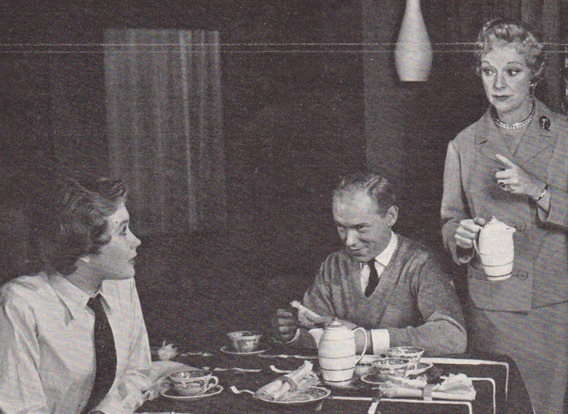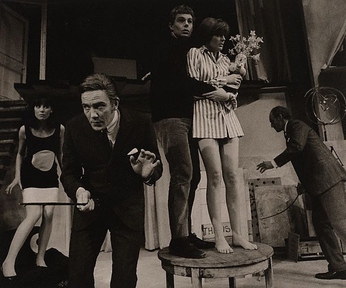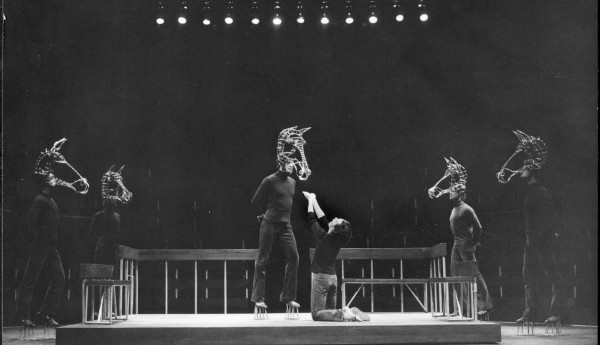Peter's Plays
Peter Shaffer recently died, just as I was in the middle of reading a collection of his work He may not be the most famous playwright, but he's been doing solid--and popular--work for almost 60 years. (He's not to be confused with his twin brother Anthony, who wrote the highly successful Sleuth.) His work was big in London and New York from the start, and featured some of the top theatrical names of the day--Ian McKellen, Michael Crawford, Albert Finney, Derek Jacobi, Lynn Redgrave, Michael Gambon, Christopher Plummer, George Rose, Alec McGowen, Peter Firth, Anthony Hopkins, Marian Seldes, Paul Scofield, Tim Curry and perhaps his favorite, Maggie Smith.
His earliest play, first performed in London in 1958, directed by John Gielgud, was Five Finger Exercise. It's about a British family and the young German tutor who teaches their teenage daughter. There's a lot of pain and a lot of tension, but if this were an American play, there'd be screaming and they'd be at each others' throats. Yet, even in the era of the Angry Young Man, Shaffer has his character try to maintain a stiff upper lip. We can see Shaffer was fully-formed as a playwright in his first work--the situation may be a bit cliched, but the dialogue is solid and the characters are memorable.
His next work was a double bill of two one-acts, The Private Ear and The Public Eye, both three-person plays using the same cast. The first is about a young man, uncertain with women, who invites a date over only to have his more experienced roommate try to pick her up; the second is about a man who hires a to detective follow his wife, only to find his wife has a relationship with the man. These are miniature pieces, but Shaffer's getting better at interpersonal relationships, and is also developing his gift for comedy, especially in the latter work.
That comic gift exploded in the longish one-act Black Comedy, which, by many accounts, was one of the funniest farces of its time. I'll have to take their word for it, since reading a farce is very different from seeing it. The piece was performed in New York in a double bill with Shaffer's White Liars, another three-person piece about two male friends who have ulterior motives in seeing a gypsy fortune teller. The evening got Shaffer his first Tony Nomination.
The idea behind Black Comedy is, literally, brilliant. The action starts with a couple entering their apartment and speaking casually, except it's done in total darkness. Then a fuse blows and the lights go on. In other words, the brighter the stage, the darker the action, so the audience gets to see all the characters--eventually there are eight in the room--groping around in what to them is total darkness. To keep the action moving, Shaffer had to figure out a reason why some people wanted everything to be dark. (If you want to know, the couple has stolen some furniture from another character who then shows up.)
Around the same time, Shaffer surprised everyone with a huge play, The Royal Hunt Of The Sun. Lots of characters and scenes and a big theme--Pizarro's conquest of Peru. It showed Shaffer was capable of epic storytelling, and also showed he loved the theatre, and felt one could do anything there.
In the 1970s, Shaffer went on to even greater success with his two biggest hits, both running three years on Broadway. First came Equus, inspired by a true crime, but greatly elaborated upon. It's about a troubled stableboy who blinds six horses, and the psychiatrist who works on his case. Once again, Shaffer has moved beyond the realistic, personal drama of his early work and is now getting closer to something mythic. The New York production won the Tony for best play.
Next came Amadeus, about the composer Salieri who devotes himself to serving the Lord through his music, only to find a foul-mouthed, childish Mozart capable of far greater work. (Schaffer was a fan of classical music, and it appears in a number of his plays.) It garnered Shaffer his second Tony for best play. Many of Shaffer's works were filmed, but the version of Amadeus, directed by Milos Forman, was the most successful, winning an Oscar for best picture and another for Shaffer's screenplay.
Shaffer, born in Britain, lived most of his adult life in New York. Yet his plays usually premiered in London. Then, he'd often rewrite them before their debut in New York. Both Equus and Amadeus, for example, were improved when he decided to make the lead characters--the psychiatrist and Salieri--more proactive, taking part in their stories rather than just narrating them. He also wrote, and rewrote, another play, Shrivings, that was presented in London but never quite worked, and didn't make it to Broadway.
His most recent play (as far as I know), Lettice And Lovage, was first performed in the late 1980s. In a way, it's a return to his older style, since it's a comedy mostly about the interaction of two characters. It was a vehicle for Maggie Smith, who played it in London and New York. She's Lettice, an eccentric woman employed as a tour guide through an historical home in England. She finds her pre-set speech dull, so starts embellishing. She's fired, but soon begins a weird relationship with her former boss. The play is as eccentric as its lead character, and shows that Shaffer still had some surprises up his sleeve.
Shaffer's work is still regularly revived around the world. He wrote such solid, entertaining stuff, I expect that to continue for many years to come.





0 Comments:
Post a Comment
<< Home